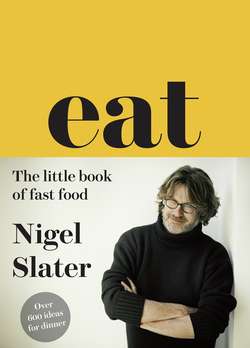Читать книгу Eat – The Little Book of Fast Food - Nigel Slater - Страница 11
Оглавление
There is an intimacy involved in eating food whilst holding it in your hands. An intimacy you cannot get from the cold steel of a knife and fork or even a pair of wooden chopsticks. The tactile quality of food in the hands is something we get from a sandwich or a wrap (a floury bap; the charcoal dust left on our fingers from a torn piece of warm roti; the cool moistness of a rice wrapper), yet it is a way of life for some cultures, who long ago embraced the art of hand-to-mouth eating.
It is convenient to contain most hand-held food in an edible wrapper – a dough of some sort. It protects our hands from the hot, messy food. A slice cut from a sourdough loaf, a baguette with a shattered crust, a flour-dusted bun, a puckered wrap, an ice-cream cornet, a doughy roti, rye crispbread or thin, skin-like rice wrapper all serve the same purpose. We get to enjoy not only the filling but its wrapper as well. A wrapper that in some cases is warm to the touch and has partially soaked up the moisture from the filling.
The sandwich can be anything from a diminutive, accurately cut cucumber triangle to a doorstop bacon butty the size of an outstretched palm. Matching the bread to the filling can be state-of-the-art or pot-luck, depending on the day. Carefully considered or bunged together, a homemade sandwich rarely fails to hit the spot. Rough pork rillettes on sourdough, goat’s cheese on walnut bread, and bacon on white sliced are amongst my desert-island sandwiches, and yes, I do plan for them when I’m shopping. But most are constructed in a somewhat more laissez-faire manner, which is why I have eaten salt beef on sourdough and Caerphilly cheese on a flat English muffin. (Both good, by the way.)
My rule of thumb is the softer the filling, the more suited it is to a crisp wrapping and vice versa. Which is why silkily wrapped rice paper rolls work so well with their crunchy cucumber and carrot filling and why smoked salmon and soft cream cheese are ideal for chewy bagels. It may also explain the heaven that is ripe Brie with a crackling baguette.
A sandwich needs some form of lubricant. This can be as off the cuff as a trickle of olive oil or as lavish as herb-flecked mayonnaise. It can bring heat (mustard, horseradish or wasabi) or be something more bland altogether, such as fromage frais. Yes, the lubricant – butter, hummus, creamed avocado, goat’s cheese, mayonnaise, Patum Peperium, jam, honey, peanut butter – needs to work with the filling but there is plenty of room to experiment. Wasabi and smoked salmon works for me, as does mayonnaise with crisp smoked bacon. Whatever works. We probably shouldn’t get too precious about a sandwich, but that needn’t mean we can be flippant about it either.
I must mention the burger. From the Big Mac to the now-ubiquitous gourmet burger, the idea of a meat patty held in some sort of bun has long had our attention. The patty is usually pork or beef, but I make them from lamb too, often with cumin and mint, and from sausage meat, mashed beans and shredded vegetables flavoured with mustard seed. The meat can be pure and lightly seasoned or tarted up with an entire spice box. Both have their moments.
In its purest form, a sandwich is something you often make for yourself rather than for someone else. The bread and its filling are ours and ours alone, and we can do as we please. There are no rules. Bread that is less than perfectly fresh can be toasted; fillings can be classic (Cheddar and coarse chutney; roast beef and horseradish) to adventurous (salmon, wasabi and grilled bacon; goat’s cheese, peach and black pepper) to downright bizarre. It can be browned in a sandwich toaster or in a film of butter in a shallow pan. Eaten hot, when the melted cheese forms burning strings, or chilled, with ice-cold radishes, cucumber and iceberg lettuce as crisp as broken glass.
The open sandwich has much to commend it. The filling is allowed to tempt the eye more than when it is held captive between two pieces of bread, and it can be more generous too. But a knife and fork are generally involved, taking away that all-important, though far from essential, tactility. An open sandwich – buttery yellow lettuce, smoked trout, dill mayonnaise and cucumber on rye – was one of the first recipes I tweeted. It remains a favourite summer lunch.
I still stand by many of the sandwiches in my first book, Real Fast Food (Michael Joseph, 1992): thinly sliced cold roast pork with sea salt, smashed crackling and mayonnaise; bread spread with anchovy paste and Camembert, toasted till the cheese runs; the bacon sarnie made with ‘plastic’ white sliced bread; even the pitta bread stuffed with fried leftover potatoes, garam masala and basil vinaigrette, despite the leap of faith you need to take to make it.
We all have our favourites. The homemade sandwich is a friend who rarely lets us down. Hand-held food rights our wrongs, turning a bad world briefly good. Here are a few of my favourites, from the simplest to the most extravagant, that continue, year in, year out, to save my soul.
